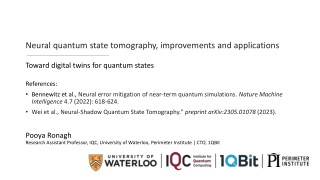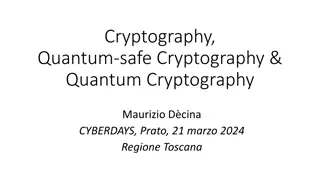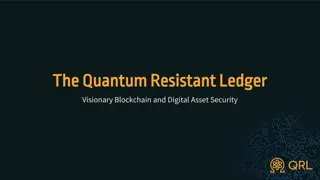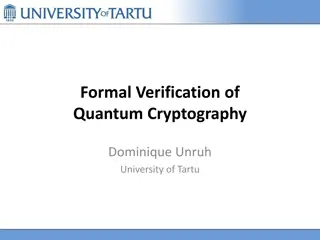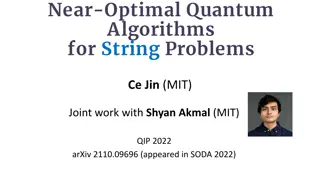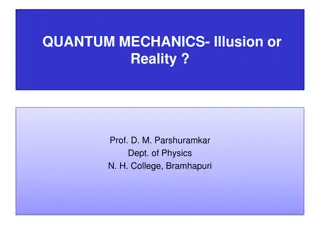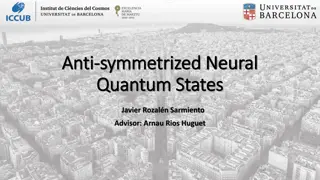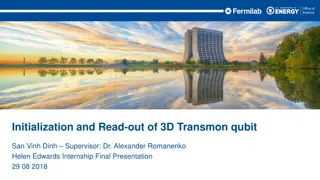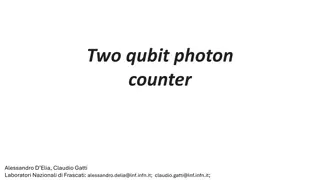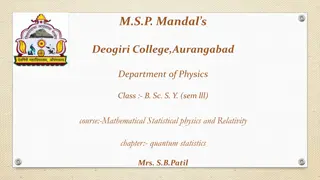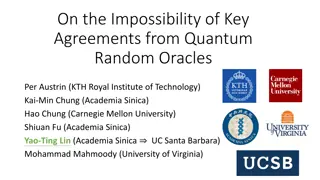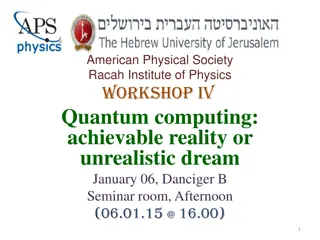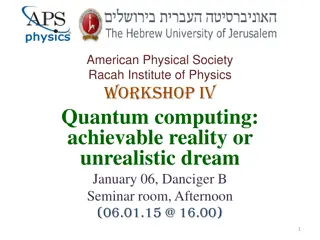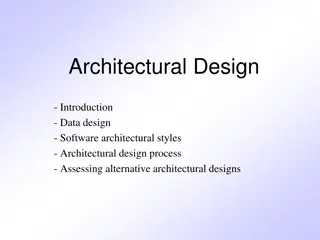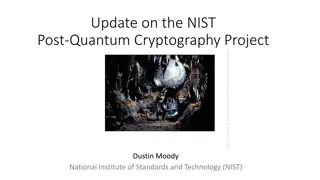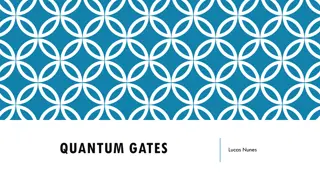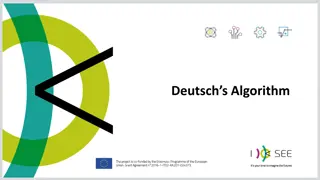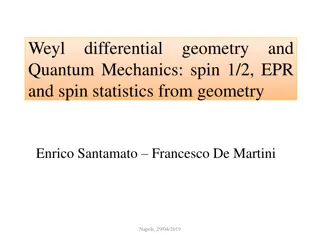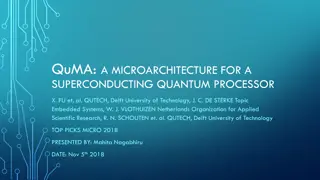Architectural Principles for a Quantum Internet
This presentation discusses the architectural principles of a Quantum Internet, highlighting the need to manage and transmit entangled states. It outlines the challenges and differences between classical and quantum networks, emphasizing the use of entanglements as the basic unit of networking. The goal is to support distributed quantum applications effectively.
Download Presentation

Please find below an Image/Link to download the presentation.
The content on the website is provided AS IS for your information and personal use only. It may not be sold, licensed, or shared on other websites without obtaining consent from the author.If you encounter any issues during the download, it is possible that the publisher has removed the file from their server.
You are allowed to download the files provided on this website for personal or commercial use, subject to the condition that they are used lawfully. All files are the property of their respective owners.
The content on the website is provided AS IS for your information and personal use only. It may not be sold, licensed, or shared on other websites without obtaining consent from the author.
E N D
Presentation Transcript
QIRG - Architectural Principles for a Quantum Internet 1
Introduction We need the capability of managing and transmitting entangled state in the quantum internet The physical devices have been proposed, but no proposal for how to work the Internet. 2
Contribution Give the principle of the quantum Internet with a high-level perspective - Quantum Internet is different from the classical Internet. There are challenges along with these difference. - According to these challenges, the architecture principle and goal has been proposed and give a general set of recommended guidelines for quantum Internet 3
Quantum Internet features No-cloning Entanglement Measurement Fidelity ... 4
The difference between quantum and classical network The quantum network is different from classical network. Nodes in quantum network are first entangled then transmit quantum messages, but classical networks transmit classical messages by forwarding. Classical network forwarding Quantum network teleportation Dahlberg, Axel, et al. "A link layer protocol for quantum networks." Proceedings of the ACM Special Interest Group on Data Communication. ACM, 2019. https://networklessons.com/cisco/ccna-routing- switching-icnd1-100-105/ip-routing-explained 5
Challenge There is no quantum equivalent of a payload carrying packet - Quantum Internet use entanglements as the basic unit of networking. It isn t like packets in classical Internet and thus also has no header. It use classical message to control. An entangled pair is only useful if the locations of both qubits are known - When qubits change, nodes entangled in the Internet should all know the information to coordinate all its actions. The nodes location is thus needed. 6
Challenge Generating entanglement requires temporary state - Classical control messages and entanglement generations often will not arrive at the destination at the same time. We need to store the state until classical messages arrive. Generating end-to-end entanglement is a parallelisable operation. - Entanglements generating isn t needed to generate in order, it can generate at the same time. The parallelizable operation has to be exploited to maximize resource utilization. 7
Goal Support distributed quantum applications - There are many quantum applications based on distribution. We need to ensure that distributing states with a sufficiently high fidelity at a reasonable rate for a majority of potential applications. Be flexible with regards to hardware capabilities and limitations - There are many different repeaters and maybe more kinds in the future. The Internet should allow for a large variety of hardware implementations 8
Principle Bell Pairs are the fundamental building block - The entanglements are the basis unit in quantum Internet, and Bell pairs can be used to generating more complex entangled state (three qubits or more) Fidelity is part of the service - Different applications may need different fidelity. The network should allocate fidelity according to applications demand. 9
Principle Time as an expensive resource - The quantum memory lifetime is short and Bell pairs generation rate is low. Thus, the entanglements can be decoherence in a short time. We should prepare and provision resources when no quantum operations are not processed. Limit classical communication - Quantum state will wait for classical message arriving. We should decrease the classical messages as much as possible. 10
Future work Generating multi-partite entanglement - How to distributingmulti-partite entanglement is the problem when consider realistic senario and above priciple Security in network operations - The attack at repeaters may break the whole entanglements. There should have some protocol to avoid it. 11
QIRG - Connection Setup in a Quantum Network 12
Introduction The quantum network is controlled by classical network nodes with classical messages. The overall behavior is like coordinated computation distributed on nodes. The hardware is heterogenetic, so the information about hardware should be collected. 13
Contribution Set up connection processes - Set the main content in request connection messages - Process the request messages 14
Concepts and Glossary Initiator: Establishing the connection by sending a message toward the Responder. Responder: The classical endpoint of the connection setup process QCap: An information block describing the quantum capabilities of a particular node and link in the request RuleSet: Describes the actions that a nodes should take in response when certain conditions occur response (Ruleset) response (Ruleset) Responder Initiator repeater request (QCap) request (QCap) 15
Message Contents and Elements PathSetupRequest: - node addresses for the Initiator and Responder - the class of service requested - minimum performance parameters (fidelity and throughput) Quantum Capabilities (QCap): - fidelity of Bell pairs created by the quantum channel - fidelity of local operations performed by the node - the entanglements creating rate RuleSets - Action: operations like swapping, duscard - Resource ID: define entanglement resource 16
Connection Setup Phases Consists of three basic phases: 1. The request send generating entanglements request and accumulate information about the node on the path in a stack of QCaps. Responder Initiator repeater request request QCap3 QCap2 QCap2 QCap1 QCap1 QCap1 17 Request Request Request
2. When the request arrives at the Responder, the Responder uses that information to create a complete RuleSet for every node. 3. The RuleSets are sent back along the original path, with each node removing its RuleSet from the message (popping the stack). Then node perform the actions it should do. Ruleset3 Ruleset1 Ruleset2 Ruleset2 Ruleset1 Ruleset1 Response Response Response response response Responder Initiator repeater 18
Why does a single node create the RuleSets for all nodes? Centralization of RuleSet creation allows a Responder to upgrade its policies independently and to improve the process if its developers have found better tuning mechanisms. A distributed mechanism would require that all nodes in the path upgrade at the same time to avoid the creation of inconsistent policies. 19
Conclusion Connection use stack to record each node quality. Then responser use ruleset stack to control each node. The responser determines the ruleset on itself 20
QIRG - The Link Layer service in a Quantum Internet 21
Introduction The quantum link layer make the ad-hoc entanglement generating be a reliable service. It provide the entanglement ID to be identify which entanglement is used. It make higher layer can use entanglement deterministically 22
Contribution It define the higher layer to link layer and link layer to higher layer request header. Propose the services in link layer 23
Services Allow both node A and B to initialize entanglement generation. Specify a desired minimum fidelity and maximum waiting time. For a successful request, provide an entanglement identifier to allow higher layers to use identify the entangled pair 24
Interface between Higher layer and link layer Higher layer send CREATE message to link layer to create entanglements local or remote Link layer send Ack and OK message to response. Ack message tell higher layer it receive and OK message tell the request result. 25
Higher layer to link layer Higher layer tell what are desired entangled nodes and other parameter describing qubit state Specify request ID as part of distant path number of created entanglements Parameter for local and remote probability distribution Request priority Type of request Rotation of measurement basis random basis in local and remote node 26
Link layer to higher layer Link layer return Ack which include Create ID. It notifies the higher layer whether requests will be scheduled for generation. The higher layer also record node ID as create ID may not be unique. Measure or keep entanglements operations have different OK message. 27
A sequence number combined with node ID for identifying the entangled pair A ID of the logical qubit in entanglement. M and K OK message request from local or remote M type include measurement basis and outcome. K type include the time of estimate goodness (fidelity) and logical qubit holding entangle- ment estimate of fidelity measurement outcome 28
Conclusion Higher layer request should contain min fidelity, max waiting time and other parameter to link layer. Link layer return OK including ID information and fidelity information and Ack message to higher layer 29
OpenSSL+QKD 2019/11/5-6 in Pan-European Quantum Internet Hackathon 30
Introduction OpenSSL is an open source cryptography library widely used on Internet application. QKD is the protocol to generate keys for encryption. The project want to use QKD in OpenSSL. The other goal is implementing it on the simulator, SimulaQron, and work applications on simulated quantum network. 31
Contribution Add European Telecommunications Standards Organization (ETSI) QKD API into OpenSSL. They try to make OpenSSL support API and provide the QKD to API. - Hacking the existing engine in openSSL to insert QKD 32
OpenSSL architecture Has the engine mechanism allowing third parties add extension with library into OpenSSL and doesn t change source code. The engine provide API to offload particular operation on special-purposed acceleration hardware Diffie-Hellman (DH) key exchange algorithm which is a excrytion algo has been used in the engine 33
Hacking the existing engine Modify the existing DH engine to the engine consist of QKD API and implementation 34
Mock QKD versus BB84 QKD running on SimulaQron The project just use mock QKD implementation but it proposed a architecture can be used in SimulaQron simulator in the future. It will run on simulated network using BB84 QKD protocol. 35
What it doesnt do It doesn t create a new first-class abstraction. It only modify existing DH engine. - The right way is modifying OpenSSL source code to introduce new algo like QKD engine which include ETSI QKD API 36
Conclusion OpenSSL can be extended by modified the engine without modifying source code The implementation on simulated network or real QKD deviced is not done yet. 37


